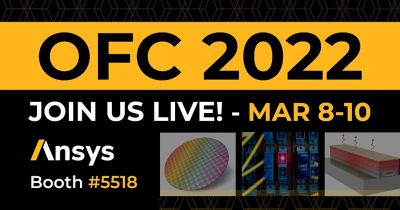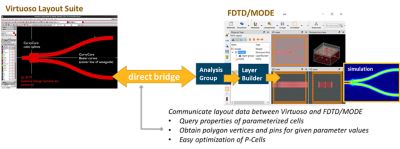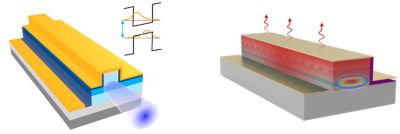-
United States -
United Kingdom -
India -
France -
Deutschland -
Italia -
日本 -
대한민국 -
中国 -
台灣
-
Ansys는 학생들에게 시뮬레이션 엔지니어링 소프트웨어를 무료로 제공함으로써 오늘날의 학생들의 성장을 지속적으로 지원하고 있습니다.
-
Ansys는 학생들에게 시뮬레이션 엔지니어링 소프트웨어를 무료로 제공함으로써 오늘날의 학생들의 성장을 지속적으로 지원하고 있습니다.
-
Ansys는 학생들에게 시뮬레이션 엔지니어링 소프트웨어를 무료로 제공함으로써 오늘날의 학생들의 성장을 지속적으로 지원하고 있습니다.
ANSYS BLOG
February 11, 2022
Explore the Future of Photonic Design with Ansys at OFC 2022
The Optical Fiber Communication Conference and Exposition (OFC) takes place March 8-10, 2022 at the San Diego Convention Center.
OFC is one of the world’s largest events for optical networks and communications representing a range of products from optical components and devices to systems, test equipment, software, and specialty fiber.
Visit Ansys at booth #5518 to explore our workflows with our electronics photonics design automation (EPDA) and foundry partners, the new capabilities in the Ansys 2022 R1 release, and Ansys’ end-to-end optics solution that combines Ansys Lumerical, Speos, and Zemax. A broad spectrum of Ansys ecosystem partners have booths at OFC including tool partners Siemens EDA, Cadence, and Luceda, and foundry partners GlobalFoundries, AIM Photonics, IMEC, SMART Photonics, LIGENTEC, and Tower Semiconductor.
At OFC, we will highlight new and existing workflows with EPDA and foundry partners, updates to the CML Compiler and Verilog-A support, new optical models for III-V materials, and workflows featuring Lumerical, Speos, and Zemax.

EPDA Workflows with Tool and Foundry Partners
This year’s OFC will highlight Ansys’ new and existing EPDA workflows available with our ecosystem partners. In addition to the existing circuit design flows with Cadence Virtuoso® and Siemens EDA, two new workflows are available with the Ansys 2022 R1 release.
A new integration to Virtuoso® Layout Suite, a custom integrated circuit design platform, provides a direct bridge to communicate layout data between Virtuoso® and Lumerical FDTD/MODE enabling direct parameter extraction and optimization of PCells.
A new integration between Ansys Lumerical INTERCONNECT and KLayout, an open-source mask layout tool, enables a layout-driven design and simulation workflow for photonic integrated circuits.
Support is now available for process-enabled custom active component design. Key foundry data needed for custom components such as layer, material, and doping information can now be shared with Ansys Layer Builder via a foundry process file.

Laser Self-Heating and Optical Material Models for III-V Materials
Join us at the Ansys booth to hear about new optical material models that provide optical index data for various III-V materials. These can be used for design with Lumerical FDTD, MODE, FEEM, and DGTD simulations, and are especially useful for the design of III-V lasers and electro-absorption modulators.
You can also learn about a new enhancement to the traveling wave laser model (TWLM) in Lumerical INTERCONNECT that enables laser simulation with self-heating. Together with our existing workflow for isothermal simulations, this enables the simulation of both the pulsed and continuous wave regimes.

Join us at the Ansys booth (#5518) to hear about these exciting new capabilities and workflows available with our ecosystem partners.










